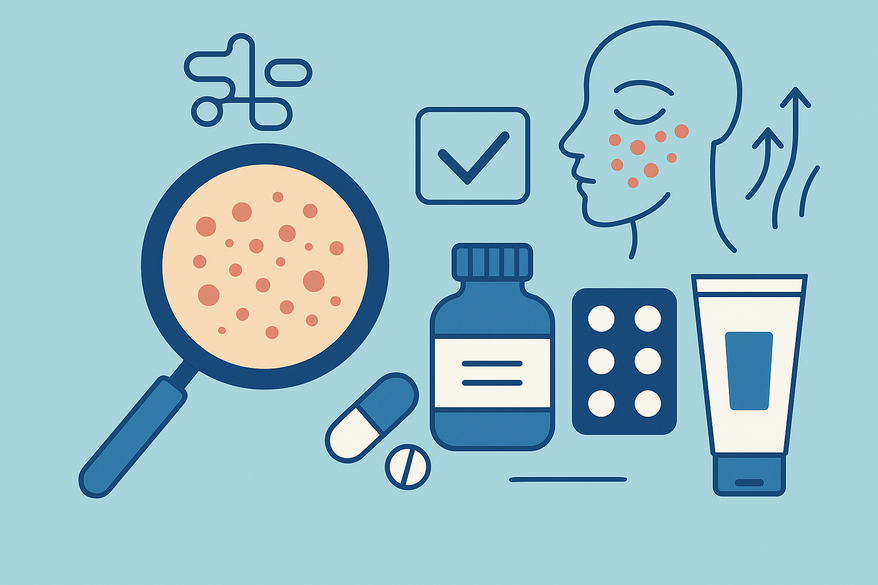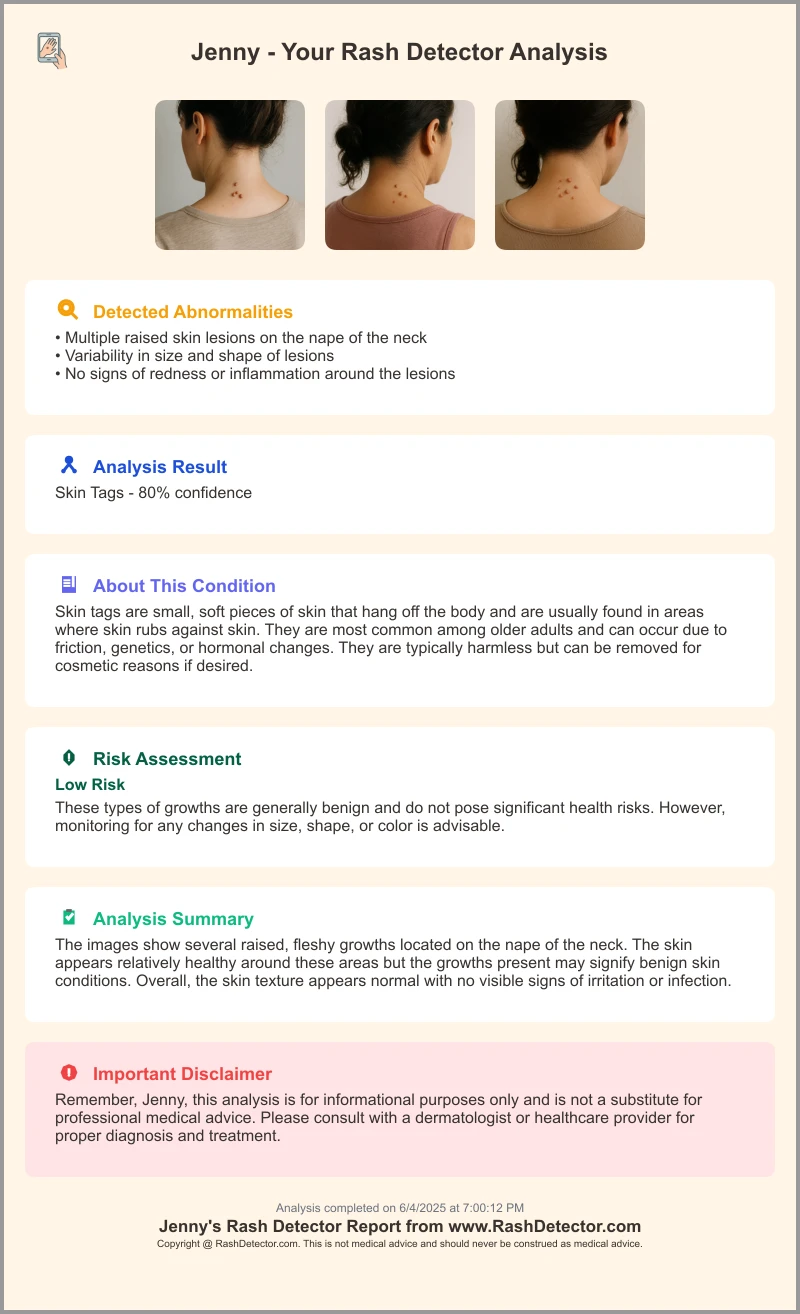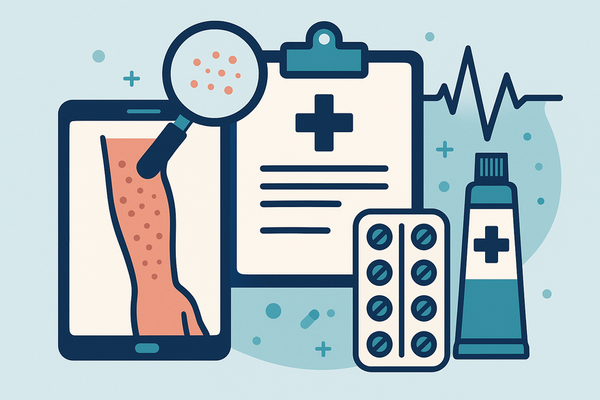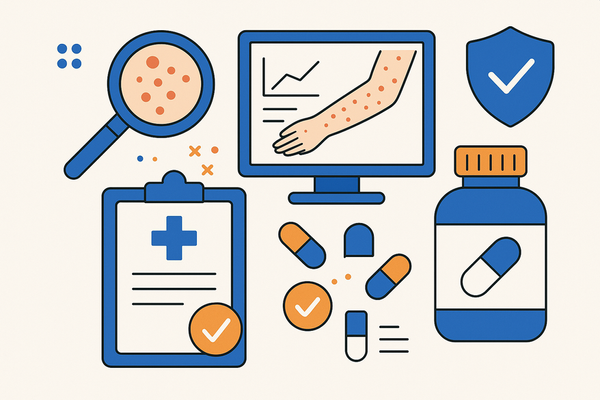Medication Rash Treatment: Comprehensive Guide to Drug-Induced Skin Reactions
Learn how to identify and manage medication rash treatment effectively to prevent worsening skin reactions, with tips on diagnosis and treatment options.

Estimated reading time: 8 minutes
Key Takeaways
- Early recognition and prompt drug discontinuation are critical to prevent mild rashes from becoming severe.
- Diagnosis relies on medication history, physical exam, and, if needed, skin or blood tests.
- Treatment ranges from OTC antihistamines and topical steroids to systemic steroids and epinephrine in severe cases.
- Home care—cool compresses, gentle skincare, behavioral tips—supports medical interventions.
- Prevention strategies like allergy testing, medical alerts, and vigilant monitoring reduce future risks.
Table of Contents
- 1. What Is a Medication-Induced Rash?
- 2. Common Causes and Risk Factors
- 3. Recognizing Signs and Symptoms
- 4. Diagnosis and When to Seek Medical Help
- 5. Medical Treatment Options
- 6. Home Remedies and Self-Care
- 7. Prevention and Future Considerations
- 8. Summary and Key Takeaways
- 9. Additional Resources
Medication rash treatment is vital when a drug triggers a skin reaction. It involves identifying and addressing these issues before they escalate. A medication-induced rash is the body’s adverse response to a pharmaceutical agent, which can range from mild redness to life-threatening conditions.
For a streamlined way to evaluate skin reactions, the AI-powered Rash Detector delivers instant analysis—you can upload images and receive a professional-grade report in seconds.

1. What Is a Medication-Induced Rash?
A medication-induced rash is a skin reaction directly tied to a specific drug—not caused by germs or irritants.
- Definition: Rashes that appear days to weeks after drug initiation and improve once the drug is stopped.
- Spectrum: From mild maculopapular eruptions and hives to severe Stevens-Johnson syndrome or toxic epidermal necrolysis.
- Importance: Early identification guides safe treatment and prevents escalation.
For details on recognizing these early warning signs, see Identifying and Managing Drug-Induced Rash Symptoms.
2. Common Causes and Risk Factors
Frequent culprits:
- Antibiotics (penicillins, cephalosporins, sulfonamides).
- Anticonvulsants (phenytoin, carbamazepine).
- NSAIDs (ibuprofen, naproxen).
Risk factors:
- Prior drug allergy history.
- Polypharmacy.
- Immune disorders (lupus, HIV).
- Genetic predisposition.
3. Recognizing Signs and Symptoms
Typical presentations:
- Red, itchy patches or flat spots.
- Hives—raised, pale welts.
- Pimples or pustules absent infection.
- Dry, flaky skin.
Warning signs:
- Itching or burning soon after drug start.
- Facial or eyelid swelling.
- Blistering or peeling skin.
- Rapidly spreading rash.
- Mucosal involvement—mouth sores, eye redness.
- Systemic symptoms—fever, chills.
4. Diagnosis and When to Seek Medical Help
Immediate steps:
- Stop suspected drug under provider guidance.
- List all medications and supplements.
Emergency red flags:
- Breathing difficulty or throat swelling.
- Widespread blistering or peeling.
Diagnostic process:
- Medication history review.
- Physical exam and vital signs.
- Lab tests—patch tests, CBC, liver/kidney panels.
5. Medical Treatment Options
Discontinue offending drug.
- Mild: OTC antihistamines, topical corticosteroids.
- Moderate to severe: Oral or IV steroids; hospitalization for Stevens-Johnson syndrome (IV fluids, wound care, ocular protection).
- Anaphylaxis: Intramuscular epinephrine, airway support.
6. Home Remedies and Self-Care
Cool compresses:
- Ice packs wrapped in a towel for 10–15 minutes.
- Calms itching and swelling.
Gentle skincare:
- Fragrance-free cleansers and lukewarm water.
- Pat dry; apply hypoallergenic moisturizer.
Behavioral tips:
- Avoid scratching; keep nails trimmed.
- Wear loose, breathable clothing.
Monitor rash daily; maintain a progress diary. For more tips, see 10 Expert Tips to Prevent Recurring Rashes.
7. Prevention and Future Considerations
- Medication review: Share drug history and cross-check for allergens.
- Allergy testing: Skin tests or specific IgE for high-risk drugs.
- Medical alerts: Bracelets and allergy cards.
- Vigilance: Watch for rash in first 2–4 weeks of new meds.
- Specialist consult: Pharmacist, allergist, or dermatologist referrals.
8. Summary and Key Takeaways
- Early recognition and prompt discontinuation are essential.
- Diagnosis via history, exam, and tests guides therapy.
- Mild rashes respond to antihistamines/topicals; severe cases need systemic treatment.
- Home care supports recovery; prevention reduces recurrence.
9. Additional Resources
- NYU Langone Health medication for drug reactions
- Cedars-Sinai Health Library medicine rash overview
- Children’s National Health System drug rash education
FAQ
- Can all drug rashes be prevented? While not all can be avoided, knowing your allergy history and monitoring new medications within the first weeks helps reduce risk.
- When should I use a topical steroid versus an oral antihistamine? Topical steroids target localized inflammation; antihistamines relieve itching and hives. Consult your provider for severe cases.
- How soon after stopping the drug will the rash improve? Mild rashes often fade within days; severe reactions may take weeks and require additional therapy.
- Are home remedies safe for all rashes? Cool compresses and gentle skincare are generally safe, but always seek medical advice if symptoms worsen.
- What should I include in my rash progress diary? Log photos, date/time, symptom changes, and any new medications or treatments.





